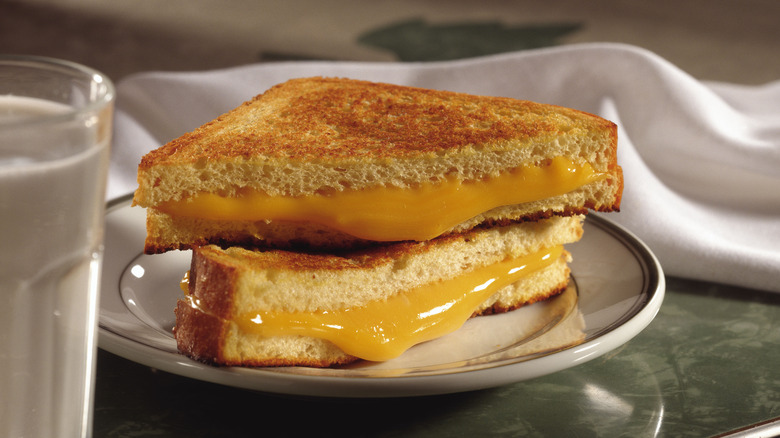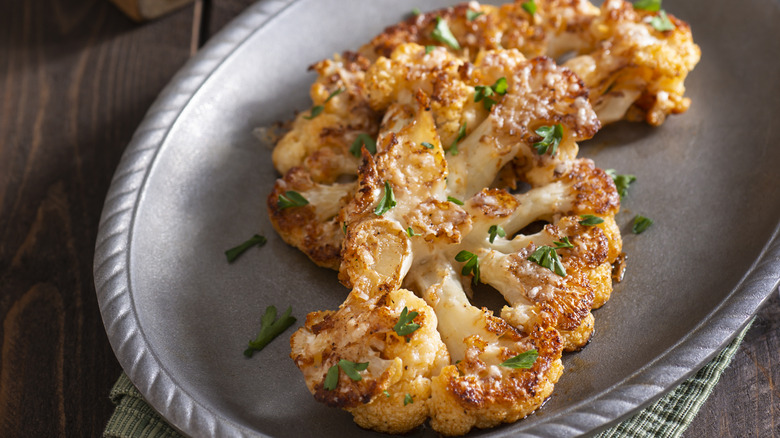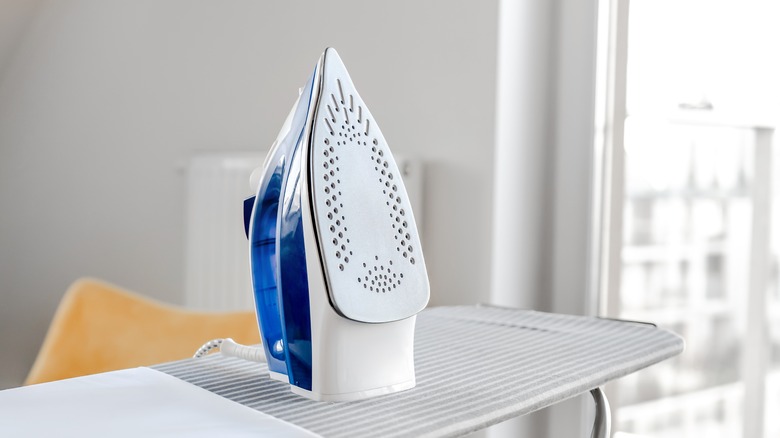How To Make Grilled Cheese Sandwiches With A Hot Iron
If you're craving comfort food and want a melty grilled cheese, the standard way to achieve that perfectly cheesy interior and toasted exterior is to cook your sandwich on the stovetop. Even a toaster can be used as a quick option (provided you have toaster bags). But if, for some reason, a clothing iron is the only item at your disposal (like when you're traveling and stuck in a hotel), you can actually use it to cook up a grilled cheese sandwich.
Since the iron is typically used to smooth out creases in clothing, it's not exactly the most sanitary tool to use in your arsenal. But, as long as you can create a barrier between the surface of the iron and the sandwich, you can protect your food from any contamination. Just use a food-safe wrapping that will hold up to the iron's heat (parchment paper and aluminum foil can both work for this purpose). Foil is particularly good as it holds heat inside the wrapping, so the sandwich doesn't cool off as you move the iron around.
Once the sandwich is wrapped up and the outer bread is coated in mayonnaise or butter to prevent sticking, make sure the iron's steam setting is off. Heat your iron to the hottest temperature — typically around 400 degrees Fahrenheit — and press it onto the wrapped sandwich. You'll know it's fully cooked once the cheese has melted, and the outer bread is lightly browned and crusty.
What else can be cooked with an iron?
Amplify this hack by adding extra ingredients to make your grilled cheese even better, or toast another kind of sandwich for something totally different. Try swapping out the bread in favor of two tortillas with some cheese in between to make a quesadilla. Or, forgo a filling altogether, toast one slice of bread, and top it off with some avocado mashed with a whisk or sweet fruit jam. You can even reheat a slice of pizza or a breakfast pastry in the same fashion, as long as you have some foil or parchment paper to create the safety barrier.
If you want to cook up something even less conventional, grab a steak and some foil. Once the cut of meat is seasoned and properly wrapped, press into it with the iron on both sides — and make sure the protein cooks up well (steaks should be heated to an internal temperature of 145 degrees Fahrenheit). After the meat has had a few minutes to rest, unwrap the foil and slice it to serve. Alternatively, slice a cauliflower like a steak and sear it the same way. Other options like marinated salmon or lamb chops can be cooked the same way — so long as they're heated to the proper temperature (that's 145 degrees Fahrenheit for both).
Precautions to take before cooking with an iron
If the hotel you're staying in doesn't offer complimentary breakfast, it might be tempting to try to cook up some scrambled eggs, pancakes, or an omelet. But keeping the iron steady to properly cook the eggs or flapjacks could prove difficult — and dangerous. Resting an iron upside down on its handle can make it prone to tipping. And if you're not careful, you might wind up with burns, either from the iron itself or the spilled hot food.
Another major factor to consider is to ensure the cooking area is food-safe and heat-safe — like a stone or stainless steel countertop. Prolonged heat on an area that won't hold up to high temperatures (a hotel room desk, for example) could cause scorch mark damage on the furniture. Instead, stick to using the iron on a kitchen countertop or an ironing board with a food-safe cover (foil or parchment).
Ultimately, if you're planning to cook any food with an iron, holding it in your hand is the safest way to ensure your food cooks correctly, as this will allow you to maintain the most control over the appliance. So while sandwiches and quesadillas may be perfectly safe to wrap up and cook by pressing down, any food that requires a balancing act is a no-go.



